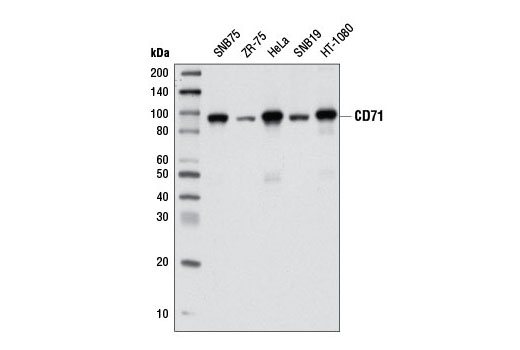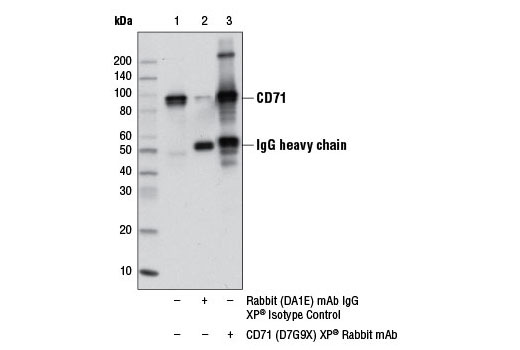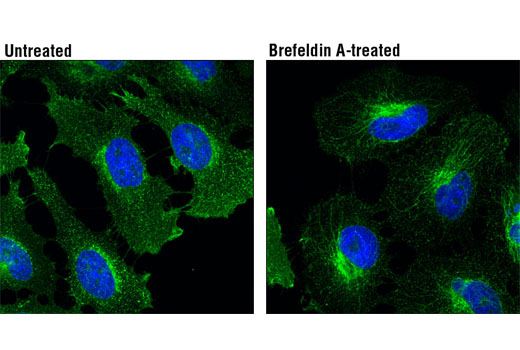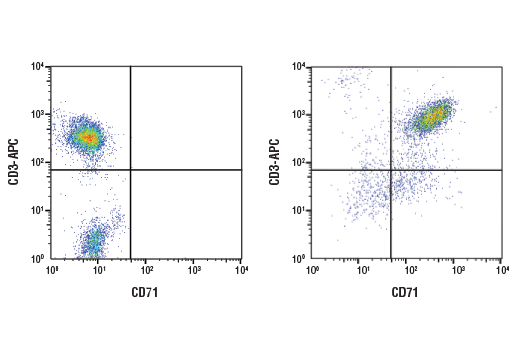WB, IP, IF-IC, FC-FP
H
Endogenous
90
Rabbit IgG
#P02786
7037
Product Information
Product Usage Information
| Application | Dilution |
|---|---|
| Western Blotting | 1:1000 |
| Immunoprecipitation | 1:100 |
| Immunofluorescence (Immunocytochemistry) | 1:50 - 1:200 |
| Flow Cytometry (Fixed/Permeabilized) | 1:100 - 1:400 |
Storage
Specificity / Sensitivity
Species Reactivity:
Human
Source / Purification
Monoclonal antibody is produced by immunizing animals with a synthetic peptide corresponding to residues surrounding Leu146 of human CD71 protein.
Background
Transferrin receptor 1 (CD71, TFRC) is a type II transmembrane receptor and carrier protein responsible for the uptake of cellular iron through receptor-mediated endocytosis (1). Neutral pH at the cell surface promotes binding of the iron-binding glycoprotein transferrin (Tf) to the CD71 receptor. The receptor-ligand complex enters the cell through receptor-mediated endocytosis and is internalized into an endosome. Relatively lower endosomal pH leads to a change in the local charge environment surrounding the iron-transferrin binding site and results in the release of iron (2). The receptor-ligand complex is recycled to the cell surface where transferrin dissociates from the CD71 receptor (2). Ubiquitously expressed transferrin receptor is continuously recycled and undergoes clathrin-mediated endocytosis regardless of ligand binding state. The interaction between receptor and ligand has been studied in detail. The helical domain of CD71 directly interacts with the transferrin C-lobe and induces a conformation change in Tf to facilitate the transport process (3). Interaction between the receptor CD71 and transferrin is mediated by the membrane protein hemochromatosis (HFE). HFE binds the α-helical domain of CD71, blocking formation of the CD71-transferrin complex and inhibiting iron uptake (4,5). In addition to binding transferrin, CD71 also interacts with H-ferritin at the cell surface and transports this intracellular iron storage protein to cellular endosomes and lysosomes (6). Additional studies indicate that the transferrin receptor is an evolutionarily conserved receptor for a number of arenaviruses and at least one retrovirus (7,8). Aberrant expression of CD71 is seen in a number of cancers, including thyroid carcinomas, lymphomas, and T-lineage leukemias, suggesting a possible therapeutic role for targeted inhibition of the transferrin receptor (9,10).
- Ponka, P. and Lok, C.N. (1999) Int J Biochem Cell Biol 31, 1111-37.
- Bali, P.K. et al. (1991) Biochemistry 30, 324-8.
- Cheng, Y. et al. (2004) Cell 116, 565-76.
- Bennett, M.J. et al. (2000) Nature 403, 46-53.
- Feder, J.N. et al. (1998) Proc Natl Acad Sci U S A 95, 1472-7.
- Li, L. et al. (2010) Proc Natl Acad Sci U S A 107, 3505-10.
- Radoshitzky, S.R. et al. (2007) Nature 446, 92-6.
- Coffin, J.M. (2013) PLoS Biol 11, e1001574.
- Magro, G. et al. (2011) Thyroid 21, 267-77.
- Rodríguez, J.A. et al. (2011) Leuk Lymphoma 52, 2169-78.
Species Reactivity
Species reactivity is determined by testing in at least one approved application (e.g., western blot).
Western Blot Buffer
IMPORTANT: For western blots, incubate membrane with diluted primary antibody in 5% w/v nonfat dry milk, 1X TBS, 0.1% Tween® 20 at 4°C with gentle shaking, overnight.
Applications Key
WB: Western Blotting IP: Immunoprecipitation IF-IC: Immunofluorescence (Immunocytochemistry) FC-FP: Flow Cytometry (Fixed/Permeabilized)
Cross-Reactivity Key
H: human M: mouse R: rat Hm: hamster Mk: monkey Vir: virus Mi: mink C: chicken Dm: D. melanogaster X: Xenopus Z: zebrafish B: bovine Dg: dog Pg: pig Sc: S. cerevisiae Ce: C. elegans Hr: horse GP: Guinea Pig Rab: rabbit All: all species expected
Trademarks and Patents
使用に関する制限
法的な権限を与えられたCSTの担当者が署名した書面によって別途明示的に合意された場合を除き、 CST、その関連会社または代理店が提供する製品には以下の条件が適用されます。お客様が定める条件でここに定められた条件に含まれるものを超えるもの、 または、ここに定められた条件と異なるものは、法的な権限を与えられたCSTの担当者が別途書面にて受諾した場合を除き、拒絶され、 いかなる効力も効果も有しません。
研究専用 (For Research Use Only) またはこれに類似する表示がされた製品は、 いかなる目的についても FDA または外国もしくは国内のその他の規制機関により承認、認可または許可を受けていません。 お客様は製品を診断もしくは治療目的で使用してはならず、また、製品に表示された内容に違反する方法で使用してはなりません。 CST が販売または使用許諾する製品は、エンドユーザーであるお客様に対し、使途を研究および開発のみに限定して提供されるものです。 診断、予防もしくは治療目的で製品を使用することまたは製品を再販売 (単独であるか他の製品等の一部であるかを問いません) もしくはその他の商業的利用の目的で購入することについては、CST から別途許諾を得る必要があります。 お客様は以下の事項を遵守しなければなりません。(a) CST の製品 (単独であるか他の資材と一緒であるかを問いません) を販売、使用許諾、貸与、寄付もしくはその他の態様で第三者に譲渡したり使用させたりしてはなりません。また、商用の製品を製造するために CST の製品を使用してはなりません。(b) 複製、改変、リバースエンジニアリング、逆コンパイル、 分解または他の方法により製品の構造または技術を解明しようとしてはなりません。また、 CST の製品またはサービスと競合する製品またはサービスを開発する目的で CST の製品を使用してはなりません。(c) CST の製品の商標、商号、ロゴ、特許または著作権に関する通知または表示を除去したり改変したりしてはなりません。(d) CST の製品をCST 製品販売条件(CST’s Product Terms of Sale) および該当する書面のみに従って使用しなければなりません。(e) CST の製品に関連してお客様が使用する第三者の製品またはサービスに関する使用許諾条件、 サービス提供条件またはこれに類する合意事項を遵守しなければなりません。



